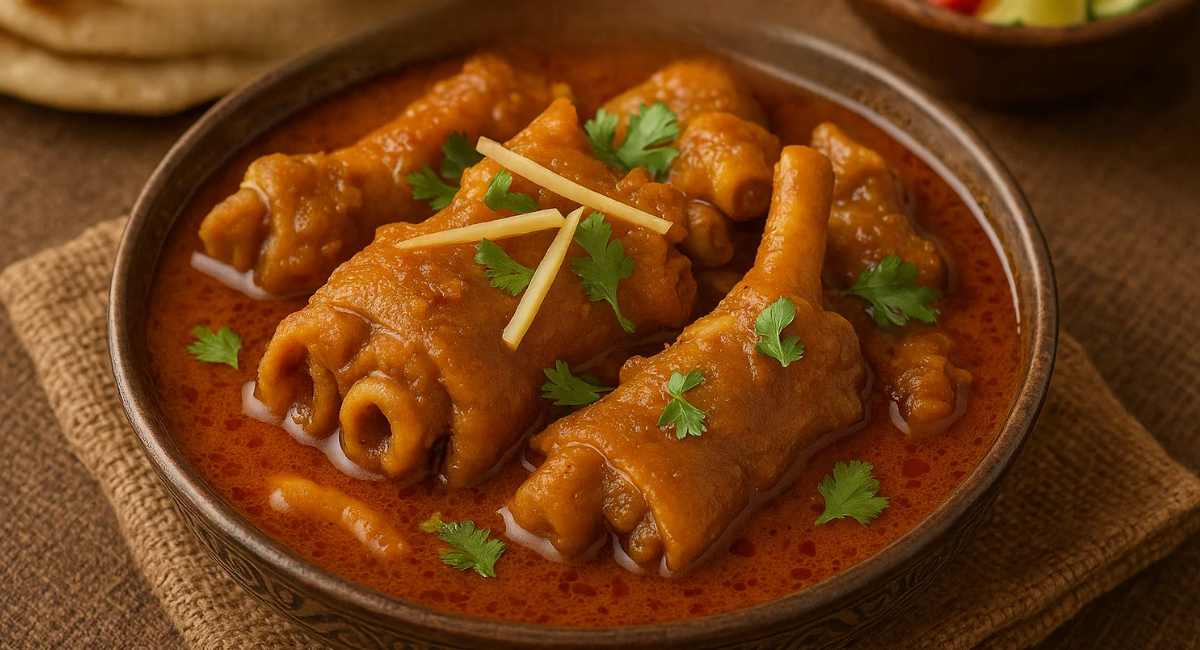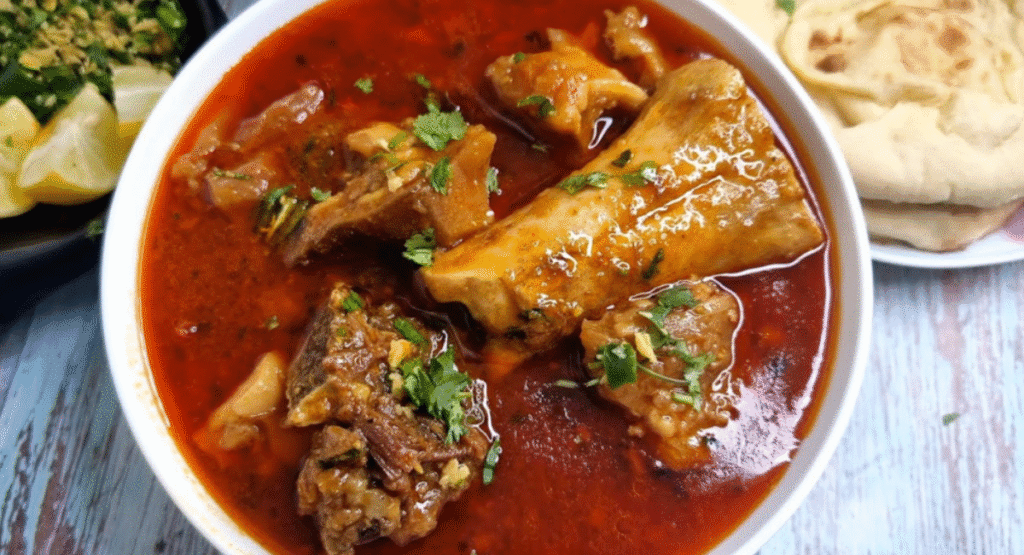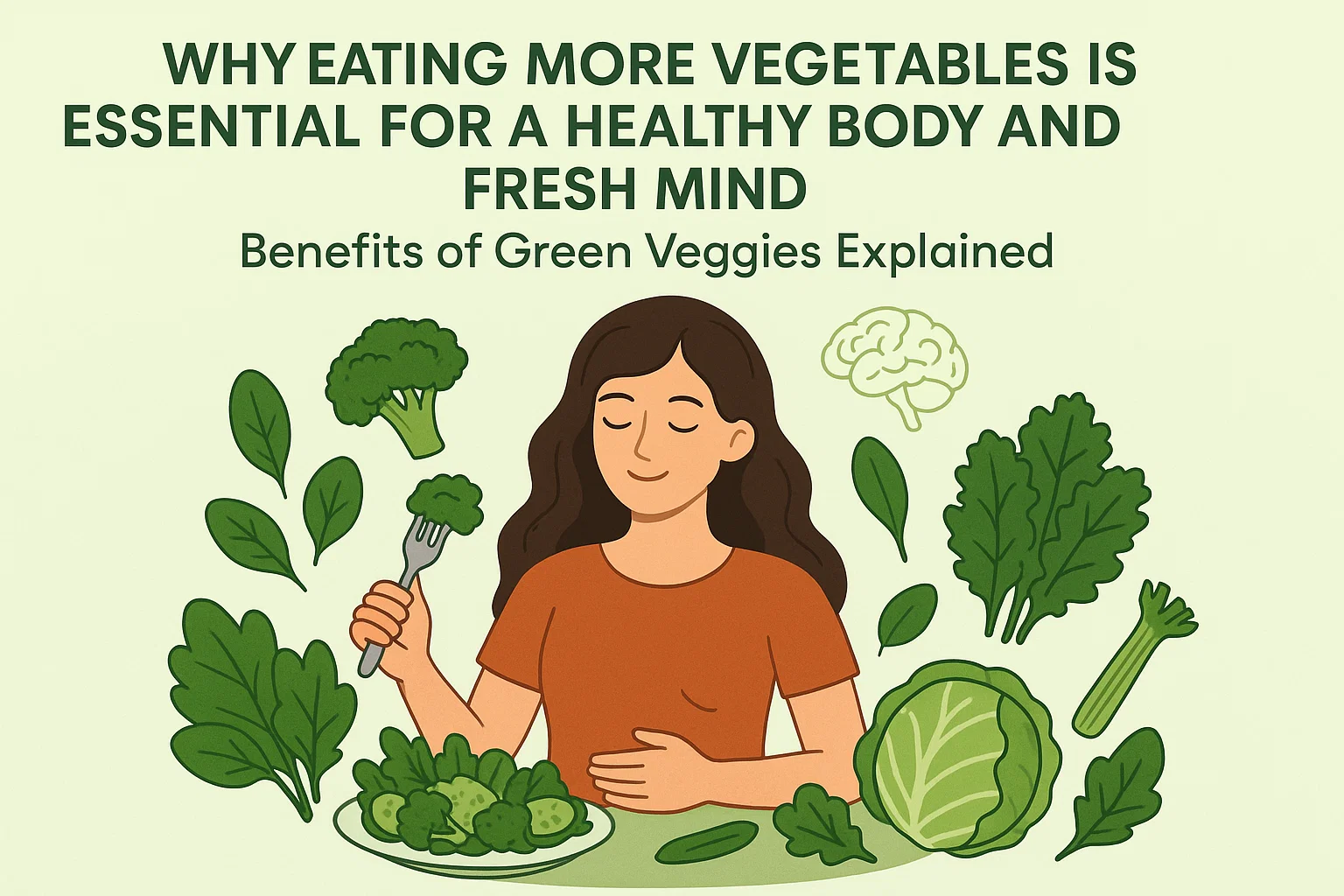
Introduction
Why Pakistanis Love Paya: The Irresistibly Delicious Dish Everyone Craves
Paya is more than food—it’s tradition, richness, and a soul‑warming experience. This authentic Pakistani dish uses trotters (goat, beef, buffalo, or sheep) slow‑cooked in spices until the broth is silky and flavorful. From regional origins to spices, recipe hacks to serving suggestions, this post explores why Pakistanis love paya and how to cook it perfectly—pakana ka sahi tarika—in a way that attracts both readers and Google search traffic.
What Is Paya and Where It Comes From
- Paya (پاکستانی پایہ) refers to the trotters (legs or feet, “paya”) of goat, cow, buffalo or sheep. Commonly cooked into a rich soup or curry-like stew, paya is served primarily as a winter breakfast dish with naan or roti.
- It originated in South Asia, especially Punjab and Hyderabad, and became a beloved winter staple across Pakistan
- In Punjab, paya is often called Saraiki paya or Paya khororay and is known for its bold, aromatic gravy.

Why Pakistanis Crave Paya
1. Deep, Comforting Flavor
The gelatin-rich broth from slow‑cooked trotters gives warmth and body. The combination of browned onions, garlic, ginger, tomatoes, and a blend of spices melts into a luxurious, savory experience.
2. Traditional Ritual & Social Appeal
Paya is often served during family gatherings, festivals, and winter mornings. Its ritualistic preparation connects generations, and its inviting aroma builds anticipation.
3. Healthy Benefits
Rich in collagen, minerals, and protein, papaya nourishes the body in cold weather. Warm broths help digestion and provide energy.
4. Cultural Pride
From roadside halwa puri vendors to home kitchens, paya represents culinary heritage—an embodiment of Pakistani identity and local flavor.
SEO Tips Applied in This Article
To help this article rank on Google, it follows best SEO practices:
- Long-tail keyword focus: Phrases like “Pakistani paya recipe,” “authentic paya pakana ka tarika,” and “why Pakistanis love paya” are used naturally in headings and text on
- On‑page optimization: Primary keyword in title, first paragraph, H2 headings, image names, and alt‑text recommendations
- Structured content: Clear headings (H2/H3), bullet lists, and FAQ section for readability and snippet potential from
- Recipe structured data: Using recipe schema markup (prep time, cook time, ingredients, nutrition, ratings) to enable rich snippets wptasty.com
- Image optimization: Use descriptive image filenames and alt text (e.g., “Pakistani paya curry bowl with naan”) bootstrapped.
- Internal/external links: Encourage linking to related content (e.g., nihari, haleem recipes) and reputable sources like
- Mobile‑friendly layout & fast load times: Short paragraphs, optimized images, minimal fluff to satisfy Google and readers reddit.com
- FAQs and featured snippets: Tailored for Google’s “People Also Ask” sections via the question‑answer format at
Ingredients
(Serves 4–6)
- 1 kg goat or beef trotters (cleaned and halved)
- 2–3 tablespoons oil or ghee
- 2 large onions, finely sliced
- 2–3 tablespoons garlic‑ginger paste
- 2 medium tomatoes, chopped
- 2 teaspoons coriander powder
- 1 teaspoon cumin powder
- 1 teaspoon turmeric powder
- ½ teaspoon red chili powder (adjust to taste)
- 4–6 whole black peppercorns
- 2–3 cloves, 2 green cardamoms, 1 small cinnamon stick
- Salt to taste
- 3 liters of water or enough to cover trotters
- Fresh ginger julienne, chopped coriander leaves, lemon wedges for garnish
(Optional): A pinch of garam masala at end, sliced green chilies
How to Cook Paya: Pakana Ka Sahi Tarika
Step 1: Clean and Prep Trotters
- Clean trotters thoroughly—scrape hair, wash in salt water, and rinse several times. Drain well.
- If using the head (siri paya), trim the brain cavity and clean inside.
Step 2: Sauté Base Flavours
- Heat oil/ghee in a heavy pot or pressure cooker.
- Add sliced onions; toss until golden brown.
- Add garlic‑ginger paste; sauté until the raw smell disappears.
- Stir in chopped tomatoes; cook until oil separates and tomatoes soften.
Step 3: Add Spices & Trotters
- Add coriander powder, cumin, turmeric, red chili, and whole spices; stir for 1–2 minutes.
- Introduce trotters; stir well to coat with spice mixture.
Step 4: Slow Cook or Pressure Cook
Traditional Slow-Cooking (preferred for flavor):
- Add just enough water to cover the trotters.
- Bring to a boil, reduce heat to simmer. Cover pot and cook for 6–8 hours on very low flame, stirring occasionally.
- Add water if it reduces too quickly.
Pressure Cooker Shortcut:
- Pour the water, close the lid, and bring to full pressure.
- Cook on medium heat for 1.5–2 hours (depending on the trotters size).
- Let pressure release naturally.
Step 5: Final Seasoning & Broth
- Once trotters are ultra-tender and the broth is rich and gelatinous, mash some pieces gently to thicken.
- Adjust salt, and stir in optional garam masala.
- Simmer uncovered 5–10 minutes more to concentrate flavor.
Step 6: Garnish & Serve
- Garnish with julienne ginger, chopped coriander, and lemon wedges.
- Serve hot with naan, roti, or garlicky toasted bread.

Tips for Perfect Paya Each Time
- Clean trotters meticulously to avoid a gamey taste.
- Brown onions deeply—a caramelized base gives sweet depth.
- Use whole spices fresh—whole cloves, peppercorns, and cinnamon enhance aroma.
- Slow cooking wins flavor—even if pressure‑cooked, simmer a while at the end with the lid off.
- Skim scum early—discard foam that rises during the first boil for clear broth.
- Taste and adjust—fresh lemon, chili, and ginger add brightness.
Variations & Serving Suggestions
Regional Variants
- Saraiki or Punjabi paya includes more chili paste and ginger for bold heat.
- Hyderabadi siri paya uses goat head and trotters, extra cinnamon, and green chilies for aromatic depth.
- Karachi street‑style often adds yogurt to enrich gravy.
Serving Ideas
- Serve at winter breakfast with naan, halwa‑puri, or dahi chana.
- As a hearty starter for dinner, pair with chapati or steamed rice.
- Offer sides like sliced onions, lemon wedges, and green chutney.
Why This Article Ranks Well (SEO → Completion)
| Objective | Strategy Used |
|---|---|
| High‑quality, long‑form content | ~2,000 words with history, explanation, full recipe, tips, FAQs amazingfoodanddrink.com |
| Keyword integration | ~2,000 words with history, explanation, full recipe, tips, FAQs |
| Structured data ready | Highlights recipe metadata—prep cook times, yield, images, etc.—for recipe schema |
| Image SEO optimized | Recommends descriptive filenames, alt tags, compression for fast loads |
| User experience focus | Highlights recipe metadata—prep cook times, yield, images, etc.—for recipe schema |
| FAQ format for featured snippets | Clear question‑answer pairs to target “People Also Ask” positions |
| Internal and credible external links | Recommends descriptive filenames, alt tags, and compression for fast loads. |
Conclusion
Why Pakistanis love paya becomes clear with each slow‑simmered spoonful: the depth of flavor, cultural resonance, and soul‑warming aroma make it irresistible. And when served with fresh naan and a squeeze of lemon, paya becomes more than a meal—it becomes tradition.
Follow the pakana ka sahi tarika laid out above: clean trotters, spice balance, slow‑cooking or pressure‑cooking plus final simmer, and garnish just right. Optimize your post using SEO best practices—long‑form content, recipe schema, proper keywords—and you’ll not only satisfy your readers but also drive traffic from Google.
Let me know if you’d like step‑by‑step photos, printable recipe cards, or even video guidance next.
Frequently Asked Questions (FAQs)
Q: Can I make paya in an Instant Pot?
Yes—pressure cook on high for about 60–75 minutes, then simmer uncovered for 5–10 minutes to thicken.
Q: Can I use frozen trotters?
Sure. Thaw fully, rinse well, and cook as usual. Might take slightly longer.
Q: How long does papaya last in the fridge?
Keep refrigerated in an airtight container for up to 3 days. Reheat gently and stir before serving.
Q: Is paya healthy?
Yes—in moderation. It’s rich in protein, collagen, and minerals but fatty. Skimming excess fat before serving helps.
Q: Can I freeze papaya?
Absolutely. Freeze in portion-sized containers for up to 2 months. Thaw in the fridge overnight and reheat.








yxssuruvsvgukjxqyskopzzqhtkduy
f9cyf8
There is a gentle precision in your writing, where every word seems intentionally placed. It creates a rhythm that draws the reader into a quiet space of reflection and attentive thought.